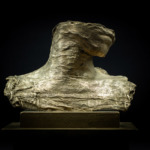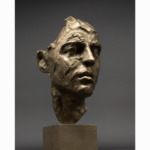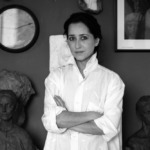
By Fanny Revault
The sculptures of Irina Shark show great virtuosity, portraying a range of feelings inspired by reality and realised through her own interpretation. Appearing frozen in time, they capture the emotion behind an expression, the singularity of a face, an intense gesture caught in a suspended moment… Casting her sharp and curious gaze on our world, Irina’s work reflects her own inner world, a world which tries to understand and express the essence of things, to go towards ‘the truth’. Interview with the young sculptor who talks to us about her passion for sculpture, her sources of inspiration, the traditional technique of her work until the final bronze.
What is your artistic training and what brought you to sculpture?
I’m a self-taught sculptor. I started to sculpt out of blue whilst living in Hong Kong – I just felt like sculpting and so I started to sculpt in my flat, alone. There weren’t any art schools where I could learn the techniques that I wanted or needed, although at the very beginning pursuing formal training didn’t cross my mind anyway.
I don’t come from an artistic family but growing up in Russia exposes you to a lot of art. I used to draw and paint a lot, and I did a lot of craft too. As far back as I can remember, sculpture has always seemed the most noble and fascinating form of art to me, as well as one which is totally out of reach – impossible to do.
You define yourself as an impressionist and expressionist sculptor. At the crossroads of these movements, how would you define your style? Emotional intensity perhaps?
Impressionism is an art movement that emerged as a reaction to the canons and rigidity of the academic realism at the end of 19th century. It is an attempt to depict an “impression”, a feeling of someone’s presence, of movements and gestures, rather than a realistic representation. Even though it’s mostly used for painting, several sculptors are also purely impressionistic, such as Paolo Troubetzkoy and Medardo Rosso.
Expressionism presents the world solely from a subjective perspective, distorting reality radically to evoke moods and ideas and show the violence of emotions. It is all about expressive intensity centred around the very personal inner world of the creator. The best example is “Scream” by Edvard Munch, as well as paintings by Van Gogh and Modigliani. In sculpture it is without doubt that the work by Bourdelle carries the best marks of expressionism.
Oscar Wilde said, “Every portrait that is painted with feeling is a portrait of the artist, not of the sitter.” Being a figurative sculptor, I attempt to create a very personal “distortion” to show the world through my own eyes – my work reflects my inner world of emotions and my emotional experiences. I accentuate lines and forms in order to express the spiritual and emotional state that I want to interpret, in an attempt to go to the truth and not just to the truth of the surface.
In this quest for Truth… What do you like to reveal?
This is a difficult question. Every time I am asked this, I must think about how to explain in one minute what took me years to learn and understand. In a way, my work reveals to me what I intended to reveal. Pierre Soulage said, “Painting does not transmit meaning, but it makes the meaning; it does not communicate. It is above all a thing that we like to see, that we like to frequent, origin and object of a dynamic of the sensitivity.” That’s so true, isn’t it?
Who are the people who inspire you?
Creative and hard-working people in all artistic fields, those who have a strong vision and who firmly believe in what they do. I find inspiration in friends who are musicians and classical dancers, as well as from great artists from the past.

Irina Shark – Medusa

Irina Shark – Le Cri

Irina Shark – Silenzio

Irina Shark – Masque d’Igor

Irina Shark – Le masque de Camille





Why did you choose bronze?
Bronze is a stunning material and the attraction for a sculptor to be able to produce their works in bronze is immense. Working with bronze is an ancient art form rooted in antiquity which extended through the middle ages right up to Rodin and the present day, and as an artist I want to be part of its continuation. Bronze can last for thousands of years and ages beautifully, acquiring with time a variety of finishes due to the differences in patinas and how they interact with the environment. Think of the amazing natural patina of the “Boxer at rest”, which was buried for centuries.
What are the different stages of your production?
I work in a traditional way: modelling the original in clay, mold making, and then bronze casting through the lost wax process. It is a long and fascinating process that requires hard physical work, most of which I do myself. Bronze casting is done in a foundry where the metal is heated to over 1200 degrees Celsius and poured as liquid – a unique and spectacular moment. During the last stages I work on the metal directly, doing the metal chasing and polishing to give the piece its final look.
When do you feel the moment of creation?
I live quite detached from reality and am very immersed in creating. In my mind, there is no separation between what is a creation and what is not a creation. I’m forever contemplating and observing – people, their faces, their features, attitudes and nature. Everything is an inspiration for potential artwork. I’m not so interested in actual “participation” in life, but rather in the accumulation of impressions that I keep in mind for future work. When I work, I experience the realisation… just the “making” of a piece, but the moment of creation is happening all the time.
What would “masterpiece” mean to you?
A true masterpiece has something complete and absolute about it that we find striking, that moves us and or even turns our world upside down. For Rodin, a masterpiece is “where there is no longer any inexpressive waste of shapes, lines and colours, but where everything, absolutely everything is resolved in thought and soul”. One cannot say it better than that.
Why do you think art is important in our lives?
Art is an emotional colouring of the colourless reality we are living in. Without imagination, without creation, things are just things, nothing has any sense. Art is a contemplation. Without it there is nothing to make us dream, nothing to transport us.
On a very basic level, art itself is not actually important. There are so many things that are more important than art. But if you combine painting, sculpture, literature, dance, music, cinema, photography, architecture and all the other disciplines and activities that can be considered as art, their influence is so vast and their value so great, that it is unthinkable to imagine our world without them.

